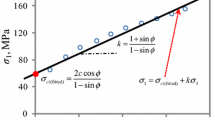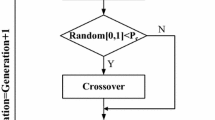Abstract
This paper investigates the results of laboratory experiments and numerical simulations conducted to examine the behavior of mixtures composed of coarse (i.e. Leighton Buzzard Sand fraction B) and fine (i.e. Leighton Buzzard Sand fraction E) sand particles. Emphasis was placed on assessing the role of fines content in mixture and strain level on the deviatoric stress and pore water pressure generation using experimental (i.e. Triaxial testing) and numerical approaches (i.e. genetic programming, GP). The experimental database used for GP modeling is based on a laboratory study of the properties of saturated coarse and fine sand mixtures with various mix ratios under a 100 kPa effective stresses in a 100 mm diameter conventional triaxial testing apparatus. Experimental results show that coarse–fine sand mixtures exhibit clay-like behavior due to particle–particle effects with the increase in fines content. It is shown that GP modeling of coarse–fine sand mixtures is observed to be quite satisfactory. The results have implications in the design of compressible particulate systems and in the development of prediction tools for the field performance coarse–fine sands.













Similar content being viewed by others
Explore related subjects
Discover the latest articles, news and stories from top researchers in related subjects.References
Georgiannou VN, Burland JB, Hight DW (1990) The undrained behaviour of clayey sands in triaxial compression and extension. Géotechnique 40(3):431–449
Salgado R, Bandini P, Karim A (2000) Shear strength and stiffness of silty sand. J Geotech Geoenviron Eng ASCE 126(5):451–462
Naeini SA, Baziar MH (2004) Effect of fines content on steady-state strength of mixed and layered samples of a sand. Soil Dyn Earthq Eng 24:181–187
Terzaghi K (1925) Erdbaumechanik auf bodenphysikalischer grundlage. Deuticke, Leipzig/Vienna
Gilboy G (1928) The compressibility of sand-mica mixtures. Proc ASCE 2:555–568
McCarthy DF, Leonard RJ (1963) Compaction and compression characteristics of micaceous fine sands and silts. Highway Research Record 22. Transportation Research Board, Washington, DC, pp 23–37
Olson RE, Mesri G (1970) Mechanisms controlling the compressibility of clay. J Soil Mech Found Div, ASCE, 96, No. SM6, Proceedings paper 7649, November, 1863–1878
Mundegar AK (1997) An investigation into the effects of platy mica particles on the behaviour of sand. M.Sc. thesis, Imperial College, London
Hight DW, Georgiannou VN, Martin PL, Mundegar AK (1998) Flow slides in micaceous sand. Problematic soils. In: Yanagisawa E, Moroto N, Mitachi T (eds) Balkema, Rotterdam, Sendai, Japan, pp 945–958
Theron M (2004) The effect of particle shape on the behaviour of gold tailings. Ph.D. thesis, University of Southampton, UK
Lade PV, Liggio CD Jr, Yamamuro JA (1998) Effects of nonplastic fines on minimum and maximum void ratios of sand. Geotech Test J ASTM 21(4):336–347
Monkul MM, Ozden G (2004) Intergranular and interfine void ratio concepts. In: 10th Turkish congress on soil mechanics and foundation engineering (ZM10), TNCSMFE, Istanbul, pp 3–12 (in Turkish)
Sidarta DE (2000) Neural network-based constitutive modeling of granular material, Ph.D. thesis, University of Illinois at Urbana-Champaign
Yagawa C, Okuda H (1996) Neural networks in computational mechanics. Arch Comp Meth Eng 4:435–512
Waszczyszyn Z (1998) Some new results in applications of backpropagation neural networks in structural and civil engineering. Advances in engineering computational technology. Civil-Comp Press, Edinburgh, pp 173–187
Kortesis S, Panagiotopoulos PD (1993) Neural networks for computing in structural analysis: methods and prospects of applications. Int J Numer Methods Eng 36:2305–2318
Waszczyszyn Z (2000) Neural networks in plasticity: some new results and prospects of applications. In: European congress on computational methods in applied sciences and engineering, ECCOMAS
Wu X (1991) Neural network-based material modeling. Ph.D. thesis. Department of Civil Engineering, University of Illinois at Urbana-Champaign
Basheer IA (1998) Neuromechanistic-based modeling and simulation of constitutive behaviour of fine-grained soils, Ph.D. thesis, Kansas State University
Ghaboussi J, Garret JH Jr, Wu X (1990) Material modeling with neural networks. In: Proceedings of the ınternational conference on numerical methods in engineering: theory and applications, Swansea, UK, pp 701–717
Ghaboussi J, Garret JH Jr, Wu X (1991) Knowledge-based-modeling of material behavior with neural networks. J Eng Mech ASCE 117(1):132–153
Penumadu D, Jin-Nan L, Chameau J-L, Sandarajah A (1994) Anisotropic rate dependent behavior of clays using neural networks. In: Proceedings of XIIIICSMFE, ICSMFE, New Delhi, India, 4, pp 1445–1448
Holland JH (1975) Adaptation in natural and artificial systems. University of Michigan Press, Ann Arbor
Goldberg DE (1989) Genetic algorithms in search, optimization, and machine learning reading. Addison-Wesley, MA
Haupt RL, Haupt SE (2004) Practical genetic algorithms, 2nd edn. Wiley-Interscience, New York
Chambers L (2001) The practical handbook of genetic algorithms applications, 2nd edn. Chapman & Hall/CRC, New York
Koza JR (1992) Genetic programming: on the programming of computers by means of natural selection. MIT Press, Cambridge, MA
GeneXpro Tools (2009) Discover the excellent of modelling with GeneXpro Tools 4.0, the best and most intutive modeling software in the market. For more information http://www.gepsoft.com/. Accessed 27 Oct 2009
Ferreira C (2001) Gene expression programming in problem solving. In: Invited tutorial of the 6th online world conference on soft computing in ındustrial applications, September 10–24
Ferreira C (2001) Gene expression programming: a new adaptive algorithm for solving problems. Complex Syst 13(2):87–129
Ferreira C (2002) Gene expression programming: mathematical modelling by an artificial ıntelligence. Angra do Heroismo, Portugal
Poli R, Langdon WB, Mcphee NF (2008) A field guide to genetic programming. Lulu.com, freely available from the internet. ISBN 978-1-4092-0073-4
Acknowledgments
The authors would like to thank Prof. C.R.I. Clayton of the University of Southampton. The first writer held a UK Overseas Research Students Awards Scheme (ORSAS) and a Ph.D. Scholarship from the University of Southampton. This study was also supported by Gaziantep University Scientific Research Projects Unit.
Author information
Authors and Affiliations
Corresponding author
Rights and permissions
About this article
Cite this article
Cabalar, A.F., Cevik, A. & Guzelbey, I.H. Constitutive modeling of Leighton Buzzard Sands using genetic programming. Neural Comput & Applic 19, 657–665 (2010). https://doi.org/10.1007/s00521-009-0317-4
Received:
Accepted:
Published:
Issue Date:
DOI: https://doi.org/10.1007/s00521-009-0317-4




